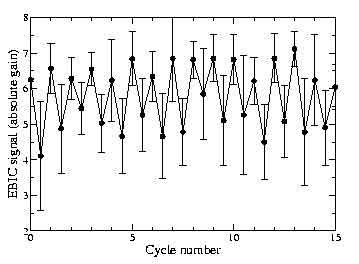Ultrahigh Density Data Storage using Epitaxial Phase-Change Media Diodes
Alison Chaiken*, 1, Gary Gibson1, K. Nauka1, C.C. Yang1, B.-S. Yeh2, R. Bicknell-Tassius2, J. Chen2, D.D. Lindig2, S. Sivaramakrishnan2, H. Liao2, J. Jasinksi3, and Z. Liliental-Weber3
1Hewlett-Packard Labs,
Palo Alto, CA 94304 USA
2Hewlett-Packard Imaging and Printing Group
3Lawrence Berkeley National Lab
This is an abstract
for a presentation given at the
11th
Foresight Conference on Molecular Nanotechnology
Commercially available rewritable DVD and CD products use laser diodes to mark amorphous bits onto polycrystalline GeSbTe or InAgSbTe phase-change media. Data readout is based on the differing optical reflectivities of amorphous and polycrystalline material. A higher density recording scheme using electron beams to write on phase-change media has been proposed.[1] At the bit density contemplated in our electron-beam project, traditional phase-change media are too inhomogeneous. One solution is to use epitaxial films with a minimum number of defects at small length scales. In addition, data readout must be based on a device which incorporates the storage medium and whose response to a scanned electron beam is sensitive to the local crystallinity.[2]
 We describe optical recording studies on MBE-grown epitaxial InSe/GaSe/Si heterojunction diode devices. Amorphous bits as small as 100 nm in diameter have been made in the InSe films using fast laser pulses (30 ns) that are shorter than the thermal equilibration time of the stack. These small optically produced bits offer a convenient surrogate for the even tinier amorphous marks to be made with high-power electron-beam sources in the future. Amorphization locally reduces the collection efficiency of the InSe/GaSe diode, enabling a readout scheme based on scanning an electron beam over the media and monitoring the electron beam induced current (EBIC). Amorphization of laser marks has been confirmed using EBIC, optical reflectivity and transmission electron microscopy (TEM). We describe optical recording studies on MBE-grown epitaxial InSe/GaSe/Si heterojunction diode devices. Amorphous bits as small as 100 nm in diameter have been made in the InSe films using fast laser pulses (30 ns) that are shorter than the thermal equilibration time of the stack. These small optically produced bits offer a convenient surrogate for the even tinier amorphous marks to be made with high-power electron-beam sources in the future. Amorphization locally reduces the collection efficiency of the InSe/GaSe diode, enabling a readout scheme based on scanning an electron beam over the media and monitoring the electron beam induced current (EBIC). Amorphization of laser marks has been confirmed using EBIC, optical reflectivity and transmission electron microscopy (TEM).
Recrystallization of the amorphous regions has been accomplished using lower-power millisecond laser pulses. Up to 100 write-erase cycles with partial restoration of reflectivity and EBIC have been achieved. The figure shows complete restoration of EBIC gain up through 15 write-erase cycles. In this particular test structure, the bits with an EBIC gain of 4-5 are written, while those with a gain over 6 are erased. Scanning electron microscopy images of the marks detect minimal changes in surface topography or composition associated with the write and erasure pulses. EBIC and TEM studies suggest that the recrystallization starts at the edge of the amorphous region and propagates into the center. The ability to cycle the material has been limited by damage to the surface, which due to the limited electron penetration depth cannot be clad with the thick dielectric protective layers used in CD-RW/DVD products.
References
[1] "A Decade Away: Atomic Resolution Storage," Scientific American, May 2000 issue.
[2] G.A. Gibson et al., U.S. Patent 5,557,596, 1996.
*Corresponding Address:
Alison Chaiken
Hewlett-Packard Labs, Mailstop 1159,
1501 Page Mill Road
Palo Alto, CA 94304 USA
Phone: 6502362231 Fax: 6508528579
Email: [email protected]
Web: http://www.wsrcc.com/alison/
|